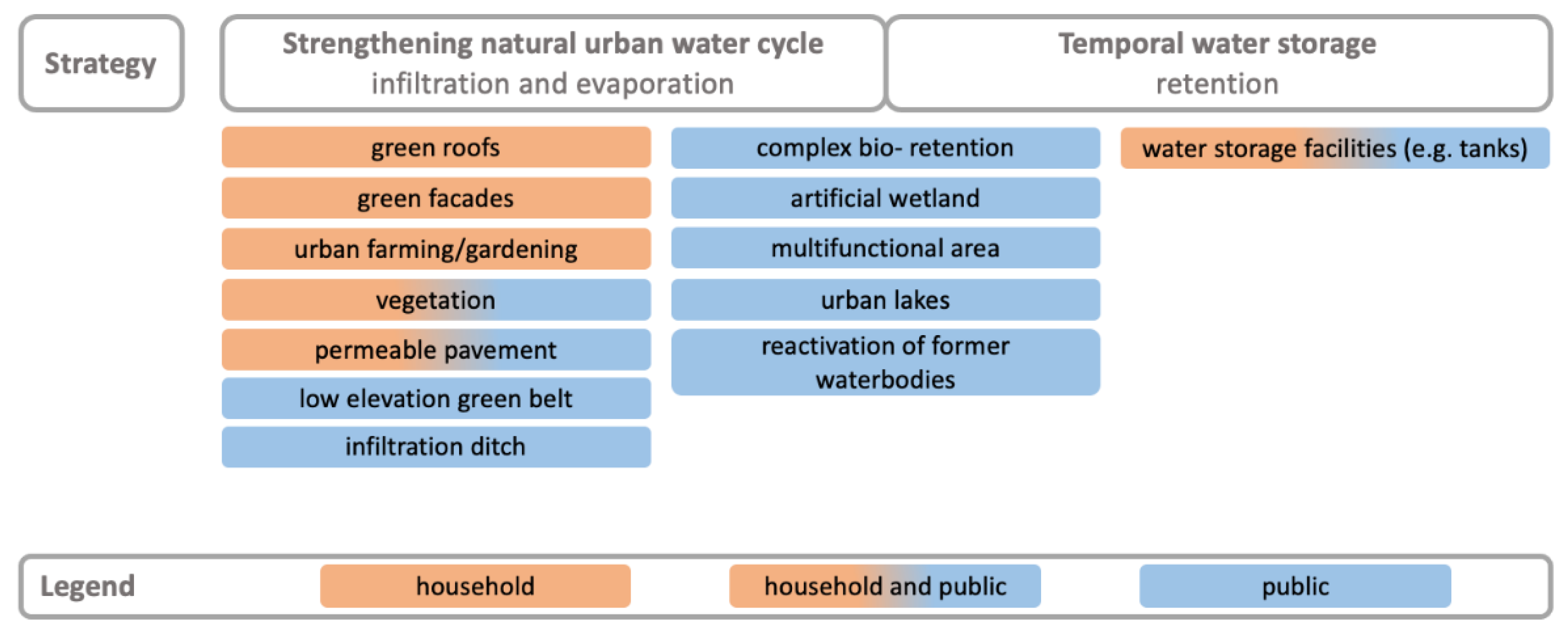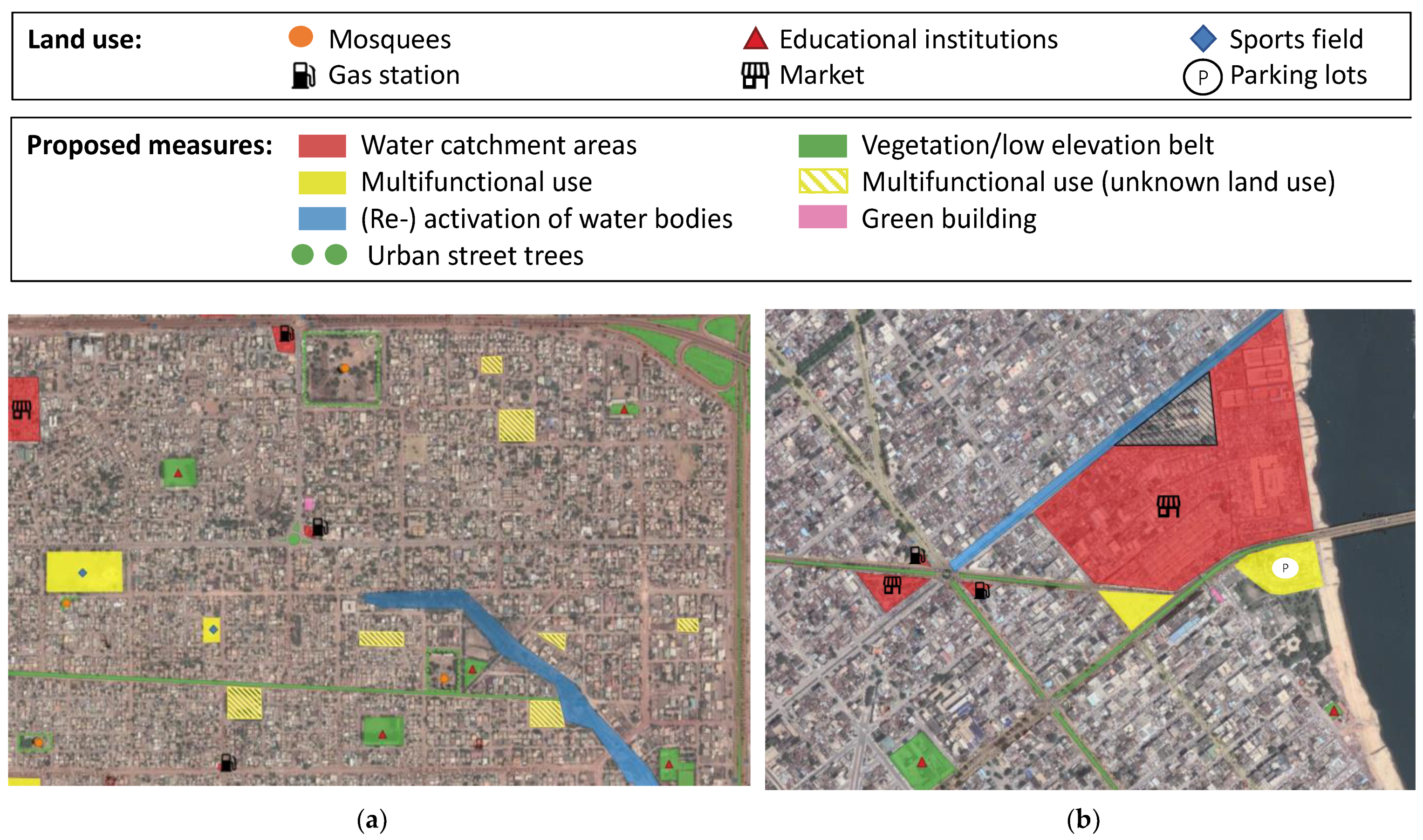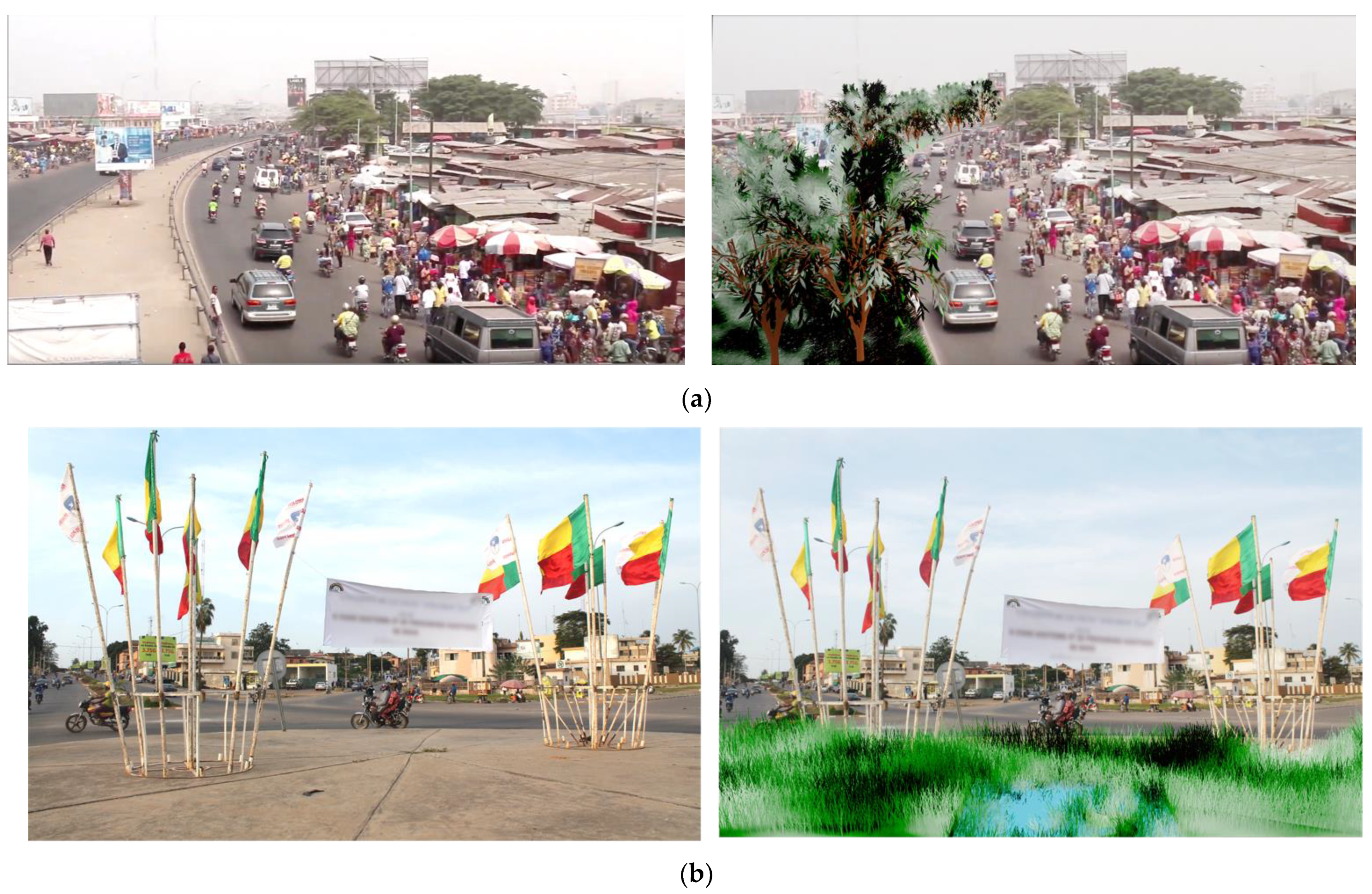Potentials for Sponge City Implementation in Sub-Saharan Africa
Abstract
1. Introduction
2. Data Availability and Methods
2.1. Data
2.1.1. Literature Research
2.1.2. Expert Interviews
2.1.3. Others
2.2. Methods
2.2.1. A Three-Stage Potential Assessment Process
2.2.2. Site Selection and Delimitation
3. Results
3.1. Step 1: Identification of Conditions
3.1.1. Hawassa, Ethiopia
3.1.2. Beira, Mozambique
3.1.3. Kigali, Rwanda
3.1.4. Cotonou, Benin
3.1.5. Ouagadougou, Burkina Faso
3.1.6. Conclusion
- Hawassa, which has experienced a rapid industrial transformation and has surrounding mountains, intensifying the surface runoff and putting additional pressure on the required drainage system;
- Beira, strongly affected by sea-level rising, recurring tidal flooding, and cyclones due to its coastline;
- Kigali, where the urban structure is modified by a resettlement of its government;
- Cotonou, with its rich and vulnerable groundwater resources;
- Ouagadougou, shaped by distinct seasons and groundwater stress.
3.2. Step 2: Design of Adjusted Measures
3.2.1. Requirements on SPC Infrastructural Elements
3.2.2. Proposed SPC Implementations
3.3. Step 3: Profit and Expenses of Implementing the SPC Concept
4. Discussion and Conclusions
Author Contributions
Funding
Institutional Review Board Statement
Informed Consent Statement
Data Availability Statement
Acknowledgments
Conflicts of Interest
References and Notes
- Bundesministerium für wirtschaftliche Zusammenarbeit und Entwicklung. Städte Nachhaltig Gestalten; Bundesministerium für wirtschaftliche Zusammenarbeit und Entwicklung Bundesministerium für wirtschaftliche Zusammenarbeit und Entwicklung: Bonn, Germany, 2016. [Google Scholar]
- Eberhard, R. Access to Water and Sanitation in Sub-Saharan Africa, Part I—Synthesis Report; Deutsche Gesellschaft für Internationale Zusammenarbeit GmbH: Bonn, Germany, 2019. [Google Scholar]
- UN-Habitat. World Cities Report 2016: Urbanization and Development—Emerging Futures; UN-Habitat: Nairobi, Kenya, 2016; Available online: https://unhabitat.org/world-cities-report (accessed on 22 June 2021).
- Bundesministerium für Wirtschaftliche Zusammenarbeit und Entwicklung. Perspektiven der Urbanisierung—Städte Nachhaltig Gestalten; No. 03/2014; Bundesministerium für Wirtschaftliche Zusammenarbeit und Entwicklung: Bonn, Germany, 2014; p. 24. [Google Scholar]
- Kappelle, M. State of the Climate in Africa 2019; World Meteorological Organization: Geneva, Switzerland, 2020. [Google Scholar] [CrossRef]
- Nkonya, E.; Johnson, T.; Kwon, H.; Edward, K. Economics of Land Degradation in sub-Saharan Africa. In Economics of Land Degradation and Improvement—A Global Assessment for Sustainable Development; Nkonya, E., Mirzabaev, A., von Braun, J., Eds.; Springer: Cham, Switzerland, 2015. [Google Scholar]
- Gaddis, E.J.B.; Voinov, A.; Seppelt, R.; Rizzo, D.M. Spatial Optimization of Best Management Practices to Attain Water Quality Targets. Water Resour. Manag. 2014, 28, 1485–1499. [Google Scholar] [CrossRef]
- Todeschini, S.; Papiri, S.; Ciaponi, C. Placement Strategies and Cumulative Effects of Wet-weather Control Practices for Intermunicipal Sewerage Systems. Water Resour. Manag. 2018, 32, 2885–2900. [Google Scholar] [CrossRef]
- Brikké, F.; Vairavamoorthy, K. Managing Change to Implement Integrated Urban Water Management in African Cities. Aquat. Procedia 2016, 6, 3–14. Available online: https://cyberleninka.org/article/n/1417608 (accessed on 14 October 2021).
- Du Toit, M.J.; Cilliers, S.S.; Dallimer, M.; Goddard, M.; Guenat, S.; Cornelius, S.F. Urban green infrastructure and ecosystem services in sub-Saharan Africa. Landsc. Urban Plan. 2018, 180, 249–261. [Google Scholar] [CrossRef]
- Titz, A.; Chiotha, S.S. Pathways for Sustainable and Inclusive Cities in Southern and Eastern Africa through Urban Green Infrastructure? Sustainability 2019, 11, 2729. [Google Scholar] [CrossRef]
- Li, Z.; Xu, S.; Yao, L. A Systematic Literature Mining of Sponge City: Trends, Foci and Challenges Standing Ahead. Sustainability 2018, 10, 1182. [Google Scholar] [CrossRef]
- Sun, Y.; Deng, L.; Pan, S.Y.; Chiang, P.C.; Sable, S.S.; Shah, K.J. Integration of green and gray infrastructures for sponge city: Water and energy nexus. Water-Energy Nexus 2020, 3, 29–40. Available online: https://reader.elsevier.com/reader/sd/pii/S2588912520300151?token=EC10C3076B35AFAD24153BF7783FEC471DF7C3510E0185512CD9264345EF8E5D08307F6553C639B8F65E548882DD465B&originRegion=eu-west-1&originCreation=20220820204944 (accessed on 20 August 2022). [CrossRef]
- Kruse, E. Integriertes Regenwassermanagement für den Wassersensiblen Umbau von Städten. Großräumige Gestaltungsstrategien, Planungsinstrumente und Arbeitsschritte für die Qualifizierung Innerstädtischer Bestandsquartiere. Ph.D. Thesis, HafenCity Universität Hamburg, Hamburg, Germany, 2015. Available online: https://repos.hcu-hamburg.de/handle/hcu/423 (accessed on 8 October 2021).
- Chan, F.K.S.; Griffiths, J.A.; Higgitt, D.; Xu, S.; Zhu, F.; Tang, Y.-T.; Xu, Y.; Thorne, C.R. “Sponge City” in China—A breakthrough of planning and flood risk management in the urban context. Land Use Policy 2018, 76, 772–778. [Google Scholar] [CrossRef]
- Köster, S. Maintenance and Safety of Sponge City Infrastructure. In Urban Water Management for Future Cities: Technical and Institutional Aspects from Chinese and German Perspective; Köster, S., Reese, M., Zuo, J., Eds.; Springer International: Cham, Switzerland, 2019; pp. 13–55. [Google Scholar] [CrossRef]
- Jones, A.; Breuning-Madsen, H.; Brossard, M.; Dampha, A.; Deckers, J.; Dewitte, O.; Gallali, T.; Hallett, S.; Jones, R.; Kilasara, M. Soil Atlas of Africa; European Commission, Publications Office of the European Union: Luxembourg, 2013; Available online: https://data.europa.eu/doi/10.2788/52319 (accessed on 22 June 2021).
- Dos Santos, S.; Ouédraogo, F.D.C.; Soura, A.B. Water-related factors and childhood diarrhoea in African informal settlements. A cross-sectional study in Ouagadougou (Burkina Faso). J. Water Health 2014, 13, 562–574. [Google Scholar] [CrossRef][Green Version]
- Merkel, A. Awassa Climate: Average Temperature, Weather by Month, Awassa Weather Averages—Climate-Data.org. 2021. Available online: https://en.climate-data.org/africa/ethiopia/southern-nations/awassa-5992/ (accessed on 28 July 2021).
- Merkel, A. Klima Kigali: Wetter, Klimatabelle & Klimadiagramm für Kigali. 2021. Available online: https://de.climate-data.org/afrika/ruanda/kigali/kigali-1044/ (accessed on 29 July 2021).
- Merkel, A. Klima Cotonou: Klimatabelle, Wetter & Wassertemperatur für Cotonou. 2021. Available online: https://de.climate-data.org/afrika/benin/littoral/cotonou-714874/ (accessed on 1 September 2021).
- Merkel, A. Klima Ouagadougou: Wetter, Klimatabelle & Klimadiagramm für Ouagadougou. 2021. Available online: https://de.climate-data.org/afrika/burkina-faso/mitte/ouagadougou-512/ (accessed on 2 September 2021).
- ‘Meteoblue.com: Simulierte historische Klima- und Wetterdaten für Beira’, Sep. 12, 2022. Available online: https://www.meteoblue.com/de/wetter/historyclimate/climatemodelled/beira_mosambik_1052373 (accessed on 2 September 2021).
- Africa Population 2022 (Demographics, Maps, Graphs). Available online: https://worldpopulationreview.com/continents/africa-population (accessed on 4 May 2022).
- Njeru, J. Interview, 18 June 2021. 2021.
- United Nations. World Urbanization Prospects—Population Division—United Nations. 2017. Available online: https://population.un.org/wup/ (accessed on 11 November 2021).
- Fournet, F.; Rican, S.; Vaillant, Z.; Roudot, A.; Meunier-Nikiema, A.; Kassié, D.; Dabiré, R.K.; Salem, G. The Influence of Urbanization Modes on the Spatial Circulation of Flaviviruses within Ouagadougou (Burkina Faso). Int. J. Environ. Res. Public Health 2016, 13, 1226. [Google Scholar] [CrossRef]
- Roos, G. Expertengespräch. 14 July 2021.
- Yamazaki, D.; Ikeshima, R.; Yamaguchi, T.; O’Loughlin, F. Topografische Karte Ouagadougou, Höhe, Relief. 2021. Topographic-map.com. Available online: https://de-de.topographic-map.com/maps/tlxo/Cotonou/ (accessed on 8 October 2021).
- Yamazaki, D.; Ikeshima, R.; Yamaguchi, T.; O’Loughlin, F. Topografische Karte Cotonou, Höhe, Relief. 2021. Topographic-map.com. Available online: https://de-de.topographic-map.com/maps/7n8e/Ouagadougou/ (accessed on 8 October 2021).
- MS Consultancy. Diagnostic Study for the Rehabilitation of Amora Gedel Constructed Wetland in Hawassa; MS Consultancy: Singapore, 2018. [Google Scholar]
- Gashu, K.; Gebre-Egziabher, T. Public assessment of green infrastructure benefits and associated influencing factors in two Ethiopian cities: Bahir Dar and Hawassa. BMC Ecol. 2019, 19, 16. [Google Scholar] [CrossRef] [PubMed]
- Zhang, X.Q.; Eichenauer, I.; Ryll, W. Financing for Resilient and Green Urban Solutions in Beira, Mozambique; UN Habitat: Nairobi, Kenya, 2020. [Google Scholar]
- Merkel, A. Beira Climate: Average Temperature, Weather by Month, Beira Water Temperature—Climate-Data.org. 2021. Available online: https://en.climate-data.org/africa/mozambique/sofala/beira-3189/ (accessed on 29 July 2021).
- Instituto Nacional de Estatística. Estatísticas Do Distrito, ‘Cidade Da Beira 2008’; Instituto Nacional de Estatística: Lisbon, Portugal, 2008.
- Doornewaard, R. Thirst? The Future Availability of Drinking Water in Beira, Mozambique. Master’s Thesis, Utrecht University, Utrecht, The Netherlands, 2015. [Google Scholar]
- Lackner, I. Drainage Rehabilitation Work for the Chiveve River in the Beira City Monitoring Report—Detailed Design Report- Solid Waste Disposal Concept for Goto Settlement; Inros Lackner: Bremen, Germany, 2014. [Google Scholar]
- Republic of Rwanda. Green Growth and Climate Resilience National Strategy for Climate Change and Low Carbon Development; National Strategy on Climate Change and Low Carbon Development: Kigali, Rwanda, 2011. [Google Scholar]
- World Bank. Rwanda—Overview. 2021. Available online: https://www.worldbank.org/en/country/rwanda/overview (accessed on 29 July 2021).
- Baffoe, G.; Ahmad, S.; Bhandari, R. The road to sustainable Kigali: A contextualized analysis of the challenges. Cities 2020, 105, 102838. [Google Scholar] [CrossRef]
- Desa, U.N. Population Division, Department of Economic and Social Affairs, United Nations Secretariat. In World Urbanization Prospects, the 2011 Revision; United Nations Publications: New York, NY, USA, 2014. [Google Scholar]
- Florczyk, A.; Corban, C.; Schiavina, M.; Pesaresi, M. GHS Urban Centre Database 2015, Multitemporal and Mulitdimensional Attrubutes, R2019A; Joint Research Centre European Commission: Luxembourg, 2019. [Google Scholar]
- Nikuze, A.; Sliuzas, R.; Flacke, J.; van Maarseveen, M. Livelihood impacts of displacement and resettlement on informal households—A case study from Kigali, Rwanda. Habitat Int. 2019, 86, 38–47. [Google Scholar] [CrossRef]
- Asumadu-Sarkodie, S.; Rufangura, P.; Jayaweera, M.P.C.; Owusu, P.A. Situational Analysis of Flood and Drought in Rwanda’, Herath Jayaweera, Middle East Technical University. 2016. Available online: https://www.researchgate.net/publication/309191249_Situational_Analysis_of_Flood_and_Drought_in_Rwanda (accessed on 29 July 2021).
- Maliki, R. Etude Hydrologique du Littoral Béninois Dans la Région de Cotonou (Afrique de l’Ouest). Ph.D. Thesis, Université Cheick Anta Diop, Dakar, Sénégal, 1993. [Google Scholar]
- Hounkpe, S.P.; Adjovi, E.C.; Crapper, M.; Awuah, E. Wastewater Management in Third World Cities: Case Study of Cotonou, Benin. J. Environ. Prot. 2014, 5, 387–399. [Google Scholar] [CrossRef]
- World Bank. Benin: World Bank Provides $100 Million to Reduce Flood Risks and Strengthen Urban Resilience in the Capital City Cotonou. 2019. Available online: https://www.worldbank.org/en/news/press-release/2019/05/23/benin-world-bank-provides-100-million-to-reduce-flood-risks-and-strengthen-urban-resilience-in-the-capital-city-cotonou (accessed on 31 August 2021).
- ASCECNA. Données Pluviométriques de Cotonou: Station de l’Aéroport de Cotonou; ASCECNA: Dakar, Senegal, 2008.
- Amoussou, E.; Totin, H.; Odoulami, L.; Edorh, P. Groundwater pollution and the safe water supply challenge in Cotonou town, Benin (West Africa). In Proceedings of the H04, IAHS-IAPSO-IASPEI Assembly, Gothenburg, Sweden, July 2013. [Google Scholar] [CrossRef]
- Sare, B.; Sina, H.; Soumanou, S.; Tente, B.; Baba-Moussa, L.; Houssou, C. Solid Waste Management Strategies at The Port of Cotonou (Benin, West Africa). Int. J. Dev. Res. 2017, 7, 1395313958. [Google Scholar]
- Raveloarison, M. Expertengespräch. 5 July 2021.
- Boyer, F.; Delaunay, D. Peuplement de Ouagadougou et Développement Urbain: Rapport Provisoire. Ph.D. Thesis, Institut de Recherche pour le Développement, Marseille, France, January 2009. [Google Scholar]
- Macrotrends. Ouagadougou, Burkina Faso Metro Area Population 1950–2021. 2021. Available online: https://www.macrotrends.net/cities/23192/ouagadougou/population (accessed on 2 September 2021).
- INSD & ICF International. Enquête Démographique et de Santé et à Indicateurs Multiples du Burkina Faso 2010; Institut National de la Statistique et de la Démographie, ICF International: Calverton, MD, USA, 2012. [Google Scholar]
- Singh, R.; Bwalya, D.; Fu, D. Feasibility and Adaptability of Sponge City Concept: A Case Study of Lusaka, Zambia. 2018. Available online: https://www.researchgate.net/publication/325796820_Feasibility_and_Adaptability_of_Sponge_City_Concept_a_Case_Study_of_Lusaka_Zambia (accessed on 2 September 2021).
- Bolay, J.-C. Urban Facts. In Urban Planning Against Poverty: How to Think and Do Better Cities in the Global South; Bolay, J.-C., Ed.; Springer International: Cham, Switzerland, 2020; pp. 7–55. [Google Scholar] [CrossRef]
- Abbott, J. Green Infrastructure for Sustainable Urban Development in Africa; Routledge: London, UK, 2012. [Google Scholar] [CrossRef]
- Jiménez, B.; Drechsel, P.; Koné, D.; Bahri, A.; Raschid-Sally, L.; Qadir, M. Wastewater, Sludge and Excreta Use in Developing Countries: An Overview. 2010, pp. 3–27. Available online: https://www.dora.lib4ri.ch/eawag/islandora/object/eawag%3A23195/ (accessed on 15 October 2021).
- Bolay, J.-C. Global Sustainability: How to Rethink Urban Planning. In Urban Planning Against Poverty: How to Think and Do Better Cities in the Global South; Bolay, J.-C., Ed.; Springer International: Cham, Switzerland, 2020; pp. 57–82. [Google Scholar] [CrossRef]
- Hunter, P.R. Climate change and waterborne and vector-borne disease: Climate Change and Disease. J. Appl. Microbiol. 2003, 94, 37–46. [Google Scholar] [CrossRef]
- Khyade, V.B.; Tyagi, B.K. Control of Vector Borne Diseases Through Microbial Paratransgenesis. Biology 2017, 4, 10. [Google Scholar]
- Müller, R.; Reuss, F.; Kendrovski, V.; Montag, D. Vector-Borne Diseases. In Biodiversity and Health in the Face of Climate Change; Marselle, M., Stadler, J., Korn, H., Irvine, K., Bonn, A., Eds.; Springer International: Cham, Switzerland, 2019; pp. 67–90. [Google Scholar] [CrossRef]
- Ember, C.R.; Ember, M. Encyclopedia of Medical Anthropology: Health and Illness in the World’s Cultures Topics—Volume 1; Cultures; Springer Science & Business Media: Berlin/Heidelberg, Germany, 2003. [Google Scholar]
- Yin, D.; Chen, Y.; Jia, H.; Wang, Q.; Chen, Z.; Xu, C.; Li, Q.; Wang, W.; Yang, Y.; Fu, G.; et al. Sponge city practice in China: A review of construction, assessment, operational and maintenance. J. Clean. Prod. 2021, 280, 124963. [Google Scholar] [CrossRef]
- Rave, H. Expert Interview. 18 May 2021.
- Tingting, L.; Chunlan, D.; Bo, L.; Yi, L. Rainwater utilization of green streets in the sustainable city. In Proceedings of the 29th IASTEM International Conference, Osaka, Japan, 7 August 2016; Volume 3, p. 5. [Google Scholar]
- Jiang, L.; Yin, C.; Qin, B. Low Elevation Greenbelt Paving Structure Based on Sponge City Ideas. CN106034818A, 26 October 2016. Available online: https://patents.google.com/patent/CN106034818A/en (accessed on 8 October 2021).
- Lexikon der Religionen. Wudu. 2020. Available online: https://religion.orf.at/lexikon/stories/3200359/ (accessed on 8 October 2021).
- Pew Research Center’s Religion & Public Life Project. Religious Composition by Country, 2010–2050. 2015. Available online: https://www.pewforum.org/2015/04/02/religious-projection-table/ (accessed on 1 October 2021).
- Schmidt, M. Pflanzenvielfalt in Burkina Faso: Analyse, Modellierung und Dokumentation. 2006. Available online: http://publikationen.ub.uni-frankfurt.de/frontdoor/index/index/docId/2202 (accessed on 8 October 2021).
- Xiong, J.; Tian, Y.; Wang, J.; Liu, W.; Chen, Q. Comparison of Coconut Coir, Rockwool, and Peat Cultivations for Tomato Production: Nutrient Balance, Plant Growth and Fruit Quality. Front. Plant Sci. 2017, 8, 1327. [Google Scholar] [CrossRef]
- Tankshop. 100mm Downpipe First Flush Water Diverter (Rain Harvesting)—WDDP02. 2021. Available online: https://www.tankshop.com.au/rain-harvesting-accessories/first-flush-water-diverters/rain-harvesting-100mm-downpipe-first-flush-water-diverter/ (accessed on 8 October 2021).
- Li, H.; Ding, L.; Ren, M.; Li, C.; Wang, H. Sponge City Construction in China: A Survey of the Challenges and Opportunities. Water 2017, 9, 594. [Google Scholar] [CrossRef]
- Liang, X. Integrated Economic and Financial Analysis of China’s Sponge City Program for Water-resilient Urban Development. Sustainability 2018, 10, 669. [Google Scholar] [CrossRef]
- Balder, H.; Ehlebracht, K.; Mahler, E. Strassenbäume: Planen—Pflanzen —Pflegen am Beispiel Berlin; Patzer: Berlin, Germany, 1997. [Google Scholar]
- King, A.; Shackleton, C. Maintenance of public and private urban green infrastructure provides significant employment in Eastern Cape towns, South Africa. Urban For. Urban Green. 2020, 54, 126740. [Google Scholar] [CrossRef]
- Federal Minimum Wage. Benin Minimum Wage—World Minimum Wage Rates 2021. 2021. Available online: https://www.minimum-wage.org/international/benin (accessed on 29 September 2021).
- Wagelindicator Foundation. Minimum Wages Regulations—Ethiopia. 2019. Available online: https://wageindicator.org/labour-laws/labour-law-around-the-world/minimum-wages-regulations/minimum-wages-regulations-ethiopia (accessed on 29 September 2021).
- UN-Water. UN World Water Development Report 2019: “Leaving No One Behind”. 2019. Available online: https://www.unwater.org/world-water-development-report-2019-leaving-no-one-behind/ (accessed on 16 October 2021).
- Villholth, K. Groundwater drought risk in sub-Sahara Africa. 2015. Water Land and Ecosystems Web site. Available online: https://wle.cgiar.org/groundwater-drought-risk-sub-sahara-africa (accessed on 16 October 2021).
- WHO. Economic and Health Effects of Increasing Coverage of Low Cost Household Drinking-Water Supply and Sanitation Interventions to Countries Off-Track to Meet MDG Target 10: Background Document to the “Human Development Report 2006”; WHO/SDE/WSH/07.05; 2007. Available online: https://apps.who.int/iris/handle/10665/69684 (accessed on 16 October 2021).
- Adekola, O. Many African Countries Are Flooding, Risking Decades of Development if They Do Not Adapt. 2018. Available online: http://theconversation.com/many-african-countries-are-flooding-risking-decades-of-development-if-they-do-not-adapt-106581 (accessed on 16 October 2021).
- DWA. DWA-M 153—Empfehlung Regenwasser (08/2007). 2007. Available online: https://webshop.dwa.de/de/merkblatt-dwa-m-153-august-2007.html (accessed on 16 October 2021).
- Hussein, A.M. Costs of environmental degradation: An analysis in the Middle East and North Africa region. Manag. Environ. Qual. Int. J. 2008, 19, 305–317. [Google Scholar] [CrossRef]
- Van de Ven, T.A.M.; Fryrear, D.W.; Spaan, W.P. Vegetation characteristics and soil loss by wind. J. Soil Water Conserv. 1989, 44, 347–349. [Google Scholar]
- Wolfe, S.; Nickling, W.G. The protective role of sparse vegetation in wind erosion. Prog. Phys. Geogr. Earth Environ. 1993, 17, 50–68. [Google Scholar] [CrossRef]
- Huang, Y.J.; Akbari, H.; Taha, H. The wind-shielding and shading effects of trees on residential heating and cooling requirements. ASHRAE Proc. 1990, 96 Pt 1. Available online: https://escholarship.org/uc/item/85g3s8xt (accessed on 23 October 2021).
- Kurn, D.M.; Bretz, S.E.; Huang, B.; Akbari, H. The Potential for Reducing Urban Air Temperatures and Energy Consumption through Vegetative Cooling; LBL-35320; Lawrence Berkeley Lab: Berkeley, CA, USA, 1994. [CrossRef]
- Akbari, H.; Kurn, D.M.; Bretz, S.E.; Hanford, J.W. Peak power and cooling energy savings of shade trees. Energy Build. 1997, 25, 139–148. [Google Scholar] [CrossRef]
- UN. The 17 Goals Sustainable Development. 2021. Available online: https://sdgs.un.org/goals (accessed on 18 November 2021).
- Aki-Sawyerr, Y. Urbanisierung in Afrika—Die Zukunft Liegt in Den Städten! Africa Business Network: Berlin, Germany, 2021. [Google Scholar]








| Location of Operation | Ethiopia Hawassa | Mozambique Beira | Rwanda Kigali | Benin Cotonou | Burkina Faso Ouagadougou | |
|---|---|---|---|---|---|---|
| Climatic zone | [-] | Tropical monsoon | Tropical wet dry savannah | Temperate | Tropical | Tropical savannah |
| Precipitation | [mm/a] | 1124 | 1609 | 991 | 1208 | 569 |
| Topography | [-] | Valley, surrounding mountains | Flat, coastline | Hilly | Flat, coastline | Tropical savannah |
| Main challenges | [-] | Flooding | Flooding, Cyclones, sea-level rise | Flooding, drought | Flooding | Flooding, drought |
| Inhabitants | [-] | 250,000 | 602,060 | 1,208,296 | 708,999 | 3,055,788 |
| Urban growth rate | [-] | n/a | 2.65 | 3.34 | 1.00 | 4.86 |
| Considerations | |
|---|---|
| Geography | Topography Climate Soil compositions |
| Vegetation | |
| Socioeconomics | Urban dynamics |
| Existing infrastructure Space-saving measures and public acceptance Local materials Reduce of health risks Low costs Simplicity |
Publisher’s Note: MDPI stays neutral with regard to jurisdictional claims in published maps and institutional affiliations. |
© 2022 by the authors. Licensee MDPI, Basel, Switzerland. This article is an open access article distributed under the terms and conditions of the Creative Commons Attribution (CC BY) license (https://creativecommons.org/licenses/by/4.0/).
Share and Cite
Thoms, A.; Köster, S. Potentials for Sponge City Implementation in Sub-Saharan Africa. Sustainability 2022, 14, 11726. https://doi.org/10.3390/su141811726
Thoms A, Köster S. Potentials for Sponge City Implementation in Sub-Saharan Africa. Sustainability. 2022; 14(18):11726. https://doi.org/10.3390/su141811726
Chicago/Turabian StyleThoms, Anna, and Stephan Köster. 2022. "Potentials for Sponge City Implementation in Sub-Saharan Africa" Sustainability 14, no. 18: 11726. https://doi.org/10.3390/su141811726
APA StyleThoms, A., & Köster, S. (2022). Potentials for Sponge City Implementation in Sub-Saharan Africa. Sustainability, 14(18), 11726. https://doi.org/10.3390/su141811726





